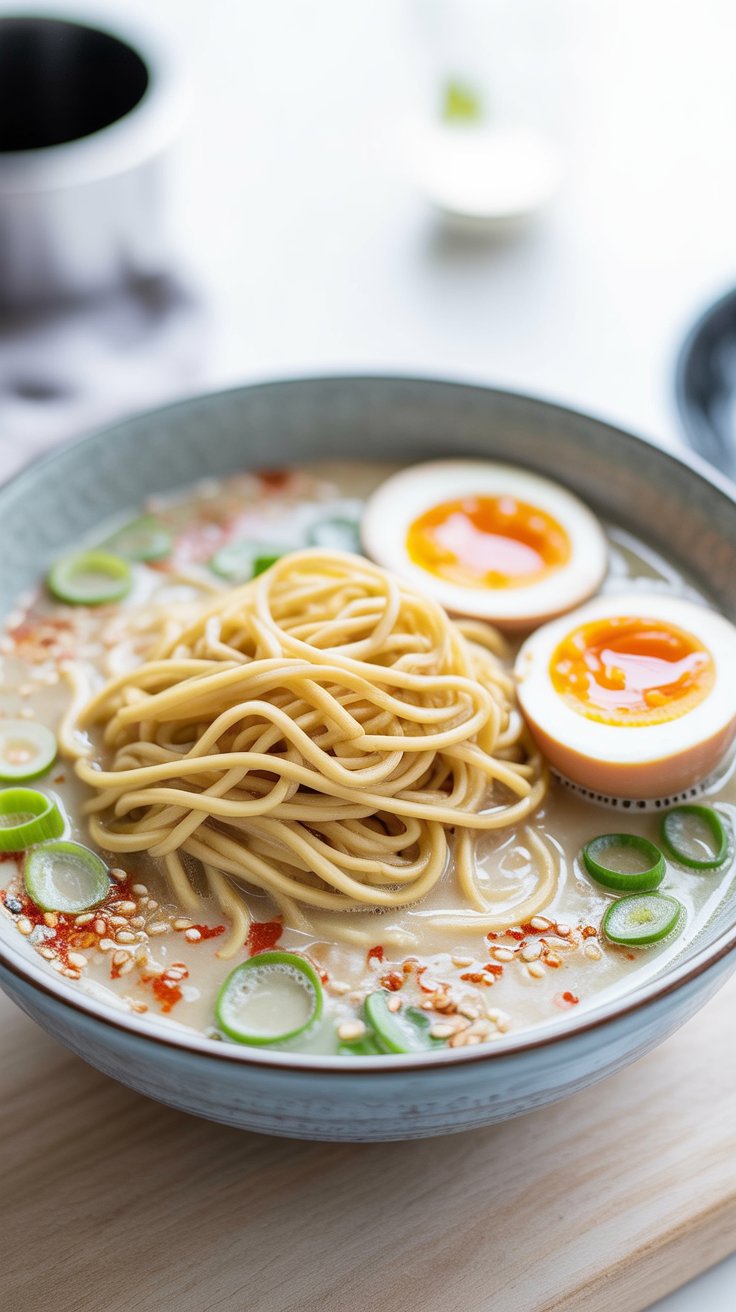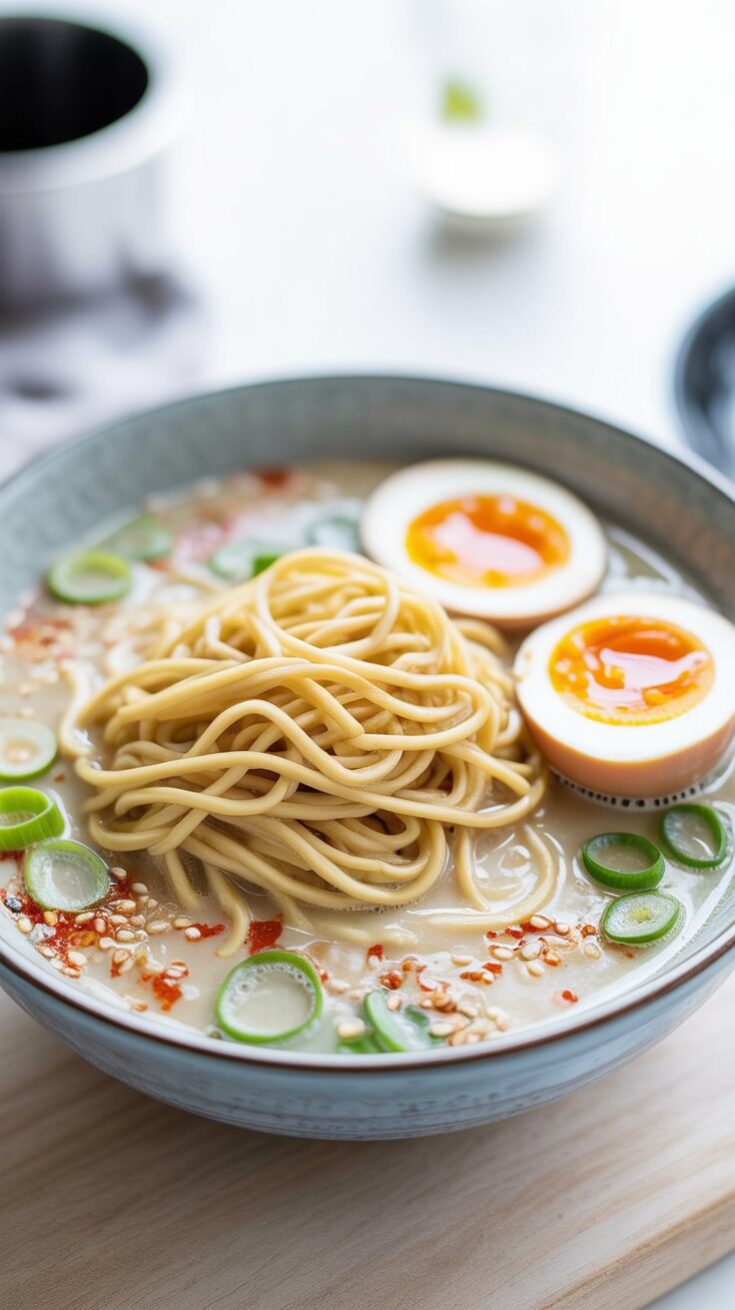Ramen has always been one of my comfort foods—the kind of meal that warms you from the inside out. Back in college, I used to live off those 99-cent instant packets, adding an egg or some frozen veggies to make them “fancy.” But once I had to cut gluten from my diet, I thought ramen was gone for good.

The first time I discovered gluten free ramen noodles at the store, I felt like I’d won the lottery. I came home, tinkered with broth, and in just 15 minutes I had a bowl that rivaled any takeout ramen. These days, I make this version at least a couple of times a month, especially on chilly evenings when nothing else will do.
Why You’ll Love This
If you’ve ever felt like gluten free eating meant missing out, this ramen will change your mind. The broth is creamy, savory, and layered with flavor from ginger, garlic, green onions, and tamari. The noodles are chewy and satisfying—everything ramen should be.
The best part? It comes together in about 15 minutes, so it’s nearly as quick as those instant packets, but a hundred times more nourishing. I love how customizable it is, too. Whether you want a simple bowl or you load it up with toppings, this soup always feels comforting and cozy.
Ingredients You’ll Need
-
Gluten free ramen noodles – I usually buy rice-and-millet ramen from Costco, but most stores now carry them. If gluten isn’t a concern, you can use regular ramen noodles too.
-
Broth – Low-sodium chicken broth or vegetable stock. If I have homemade bone broth, I use that for extra richness.
-
Unsweetened soy milk – This is my little secret for making the broth creamy. Almond milk works, but stay away from sweetened or flavored varieties.
-
Tamari – A gluten free soy sauce alternative that brings deep, savory flavor.
-
Rice wine vinegar – Adds brightness. Mirin is a good swap if you want something more traditional.
-
Garlic, ginger, and green onion – Fresh aromatics that build a flavorful base.
-
Sesame oil – Toasted sesame oil adds that nutty finish that makes the broth sing.
Tip from my kitchen: I sauté the white parts of the green onions with the ginger and garlic, then save the green tops for garnish. It gives you layers of onion flavor without overpowering the broth.
Cooking Tips That Make a Difference
-
Cook the noodles separately. It keeps the broth from turning starchy and prevents the noodles from getting gummy.
-
Pull the noodles early. They’ll continue softening once they hit the hot broth, so slightly undercooking them keeps that chewy bite.
-
Add tamari and vinegar at the end. This preserves their sharp, bright flavor instead of dulling it during simmering.
-
Season carefully. Tamari is naturally salty, so taste before adding extra salt.

Topping Ideas
This ramen is delicious as is, but toppings take it from good to unforgettable. Some of my favorites:
-
Protein: Soft-boiled egg, shredded chicken, shrimp, tofu, or thinly sliced beef.
-
Veggies: Baby spinach, bok choy, shiitake mushrooms, corn, or napa cabbage.
-
Extras: Nori sheets, togarashi, furikake, chili oil, or crispy garlic.
On weeknights, I usually keep it simple with an egg and a sprinkle of chili crunch. On weekends, I go all out and turn it into a loaded ramen bowl.
Variations You’ll Love
-
Spicy ramen: Add chili oil, chili crunch, or a spoonful of chili garlic paste before serving.
-
Miso ramen: Stir miso paste into the aromatics before adding broth and soy milk.
-
Mushroom ramen: Sauté shiitake mushrooms with the garlic and ginger for extra umami.
-
Soy free version: Use coconut aminos instead of tamari and almond milk instead of soy milk.
Storage and Make-Ahead Tips
Ramen is best eaten fresh, but you can prep parts ahead:
-
Broth: Make a big batch and keep it in the fridge for 3–4 days.
-
Noodles: Cook, drain, and toss in a little sesame oil before storing. They’ll keep in the fridge for up to 2 days without clumping.
-
Assembly: Keep noodles and broth separate until serving. Pour hot broth over the noodles just before eating, and you’ll have a fresh-tasting bowl every time.

FAQs
Are Japanese ramen noodles gluten free?
Traditional ramen noodles are made with wheat, so they’re not gluten free. Luckily, rice- and millet-based ramen noodles are widely available now.
What’s the best gluten free ramen noodle brand?
I like the rice ramen from Lotus Foods—they’re chewy and hold up well in hot broth. Costco often sells value packs.
Which broth should I use?
Any broth works, but make sure it’s gluten free. Use tamari or coconut aminos for seasoning instead of regular soy sauce.
Can I make this vegan?
Yes! Just use vegetable broth instead of chicken. The rest of the ingredients are already vegan-friendly.
Gluten Free Ramen Noodles

A warm, comforting bowl of ramen can be yours in just 15 minutes — no gluten required!
Ingredients
- 1 cake gluten free rice ramen noodles, cooked per package instructions
- 1 cup unsweetened soy milk (or almond or oat milk)
- 1 cup low sodium chicken or vegetable broth
- 2 tablespoons gluten free tamari (or soy sauce, or coconut aminos)
- 1 tablespoon rice wine vinegar (or mirin)
- 1 teaspoon sesame oil (or avocado oil, coconut oil, or other neutral oil)
- ½ teaspoon minced garlic (about 1 clove)
- ½ teaspoon minced ginger (about ½ inch piece)
- 1 green onion, thinly sliced (white and green parts divided)
Optional Add-ins
- spice: chili garlic paste, chili oil, or chili crisp
- vegetables: bok choy, spinach, broccoli, carrots, corn, microgreens
- protein: soft or hard-boiled egg, shredded chicken, shrimp, pork belly, or tofu
- toppings: sesame seeds, togarashi, furikake, or nori strips
Instructions
- Heat sesame oil in a small pot over medium heat. Add the white part of the green onion along with garlic and ginger, sautéing for 2–3 minutes until fragrant.
- Pour in the soy milk and broth, stirring well. Bring to a gentle simmer and let it cook for about 5 minutes until warmed through.
- Turn off the heat, then stir in the tamari and rice wine vinegar. Add the cooked ramen noodles to the pot, tossing lightly to coat them in the broth.
- Serve hot, topped with the green onion tops and your choice of vegetables, proteins, or spices.
Final Thought
This gluten free ramen is proof that comfort food doesn’t have to be complicated—or off-limits if you’re avoiding gluten. With a handful of pantry ingredients and just 15 minutes, you can have a steaming bowl of creamy, flavorful noodles that feels both nourishing and indulgent.
Every time I make it, I’m reminded of those cozy nights when a bowl of ramen was the answer to everything—from long days to cold weather. Now, it’s a recipe I rely on again and again, and I think you’ll find yourself craving it, too.

